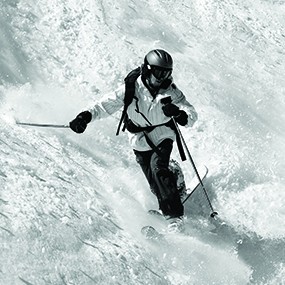Christopher Creveling, a native Utahn, grew up with a passion for math and science and wanted to do something that encompassed both. Engineering was the optimal combination of calculus and physics and incorporated his love of building things. With a great GPA and an awe-inspiring list of extracurricular activities and service (including co-captain of the water polo team, multiple honor society leadership positions and assistant photo editor for the Daily Utah Chronicle), Creveling could have gone anywhere for graduate school.
However, there wasn’t any other place but Utah that coupled his desire for learning with his passion for outdoor recreation. With six world-renowned ski resorts within 30 minutes of the university and five national parks merely hours away, he knew the University of Utah was the place for him. Creveling’s photographs of Utah’s beauty are truly phenomenal, and he hopes they will inspire others to explore the outdoor opportunities that Utah has to offer.

What was not in Creveling’s plan was that he would end up applying his mechanical engineering background to better understanding the human body. “Kiffer [as he his known to his friends] was a little hesitant to join the lab” says Ph.D. advisor Brittany Coats. “He hadn’t been exposed to anything but gears, turbines, and beams. The mechanics of biological tissues was new to him. He took a leap of faith, and he is now on track to make a substantial contribution to the prevention of vision loss in elderly and improving the identification of child abuse in children.”
Creveling’s research is focused on elucidating adhesion mechanics at the vitreoretinal interface in our eyes and quantifying how it changes with age. The majority of the eye is composed of vitreous, a clear substance that fills the void between the lens and the retina. In infancy, the vitreous is more gel-like. Over time it begins to degrade and liquefy. This liquefaction causes the vitreous to sag, pulling and disrupting the retina, the critical layer that transmits light signals from the outside world to the brain. This can result in vision loss. Christopher’s work identifying the mechanisms and forces of adhesion between the vitreous and the retina will allow targeted treatment strategies to eliminate vitreoretinal traction before damage occurs.
On the other end of the age spectrum, the more gel-like vitreous of infants proves problematic in traumatic scenarios. During rapid head rotation, it is believed that the more elastic characteristics of the infant vitreous increases traction force applied to the retina. This increased force can cause retinal hemorrhage or detachment. Creveling’s research will identify how force is transmitted across the interface, and quantify the forces required to produce retinal damage. “It is our hope that we can use this information to better distinguish between the forces associated with accidental and inflicted trauma in infants,” he says.
“The work that Kiffer is doing is a mix of mechanical engineering, microstructural imaging, and immunohistochemistry,” says Coats. “They say that all interesting problems are multifaceted. That is definitely the case here. I can think of no one better than Kiffer to tackle it.”